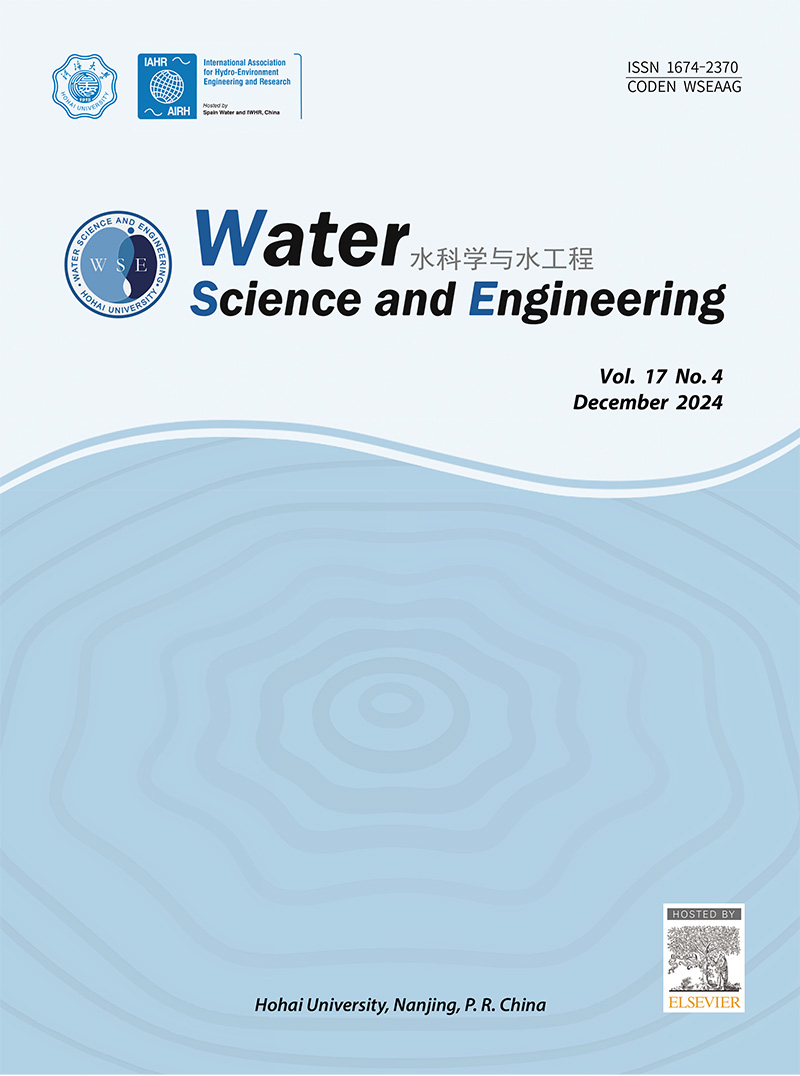Enhanced total nitrogen removal and membrane fouling control by increasing biomass in MBR equipped with ceramic membrane
IF 4.3
Q1 WATER RESOURCES
引用次数: 0
Abstract
Simultaneous nitrification and denitrification (SND) is an efficient method to remove nitrogen in municipal wastewater treatment. However, low dissolved oxygen (DO) concentrations are generally required, leading to serious membrane fouling in membrane bioreactors (MBRs). This study aimed to clarify the synergistic effect of biomass and DO on nitrogen removal and membrane fouling. To achieve this goal, four submerged MBRs equipped with ceramic membranes were operated with different biomass (mixed liquor suspended solids (MLSS)) concentrations (3 000 mg/L, 5 000 mg/L, 7 500 mg/L, and 12 000 mg/L) under various DO concentrations (2.0 mg/L, 1.0 mg/L, and 0.5 mg/L). As a result, increasing biomass in the MBRs enhanced total nitrogen (TN) removal via SND, and excellent TN removal efficiencies of 60.7% and 75.8% were obtained using the MBR with an MLSS concentration of 12 000 mg/L and DO concentrations of 2.0 mg/L and 1.0 mg/L. However, a further decrease in DO deteriorated TN removal due to the inhibition of nitrification. Moreover, high MLSS concentrations were beneficial to membrane fouling control for ceramic membranes in MBRs. The lowest transmembrane pressure development rate was observed for the MBR with an MLSS concentration of 12 000 mg/L. High biomass offset the adverse effect of DO decrease on membrane fouling to some extent, and improved the stability of the reactor. Therefore, biomass might be an important parameter for membrane fouling reduction in ceramic MBRs. Overall, optimal biomass and DO concentrations for TN removal were identified, providing useful information for the successful operation of MBRs with efficient TN removal and membrane fouling control.
在配备陶瓷膜的 MBR 中通过增加生物量提高总氮去除率和膜堵塞控制能力
在城市污水处理中,同时硝化和反硝化(SND)是一种有效的脱氮方法。然而,这种方法通常需要较低的溶解氧(DO)浓度,从而导致膜生物反应器(MBR)中膜严重堵塞。本研究旨在阐明生物质和溶解氧对脱氮和膜堵塞的协同效应。为实现这一目标,在不同溶解氧浓度(2.0 毫克/升、1.0 毫克/升和 0.5 毫克/升)条件下,使用不同生物量(混合液悬浮固体(MLSS))浓度(3 000 毫克/升、5 000 毫克/升、7 500 毫克/升和 12 000 毫克/升)运行了四个配备陶瓷膜的浸没式 MBR。因此,在 MLSS 浓度为 12 000 mg/L、溶解氧浓度为 2.0 mg/L 和 1.0 mg/L 的 MBR 中,生物量的增加提高了通过 SND 去除总氮 (TN) 的效果,TN 去除率分别达到 60.7% 和 75.8%。然而,由于硝化作用受到抑制,溶解氧的进一步减少会降低 TN 的去除率。此外,高浓度的 MLSS 有利于控制 MBR 中陶瓷膜的膜堵塞。在 MLSS 浓度为 12 000 mg/L 的 MBR 中观察到最低的跨膜压力发展率。高生物量在一定程度上抵消了溶解氧减少对膜堵塞的不利影响,并提高了反应器的稳定性。因此,生物量可能是陶瓷 MBR 中减少膜污垢的一个重要参数。总之,确定了去除 TN 的最佳生物量和溶解氧浓度,为高效去除 TN 和控制膜污垢的 MBR 的成功运行提供了有用的信息。
本文章由计算机程序翻译,如有差异,请以英文原文为准。
求助全文
约1分钟内获得全文
求助全文
来源期刊

Water science and engineering
WATER RESOURCES-
CiteScore
6.60
自引率
5.00%
发文量
573
审稿时长
50 weeks
期刊介绍:
Water Science and Engineering journal is an international, peer-reviewed research publication covering new concepts, theories, methods, and techniques related to water issues. The journal aims to publish research that helps advance the theoretical and practical understanding of water resources, aquatic environment, aquatic ecology, and water engineering, with emphases placed on the innovation and applicability of science and technology in large-scale hydropower project construction, large river and lake regulation, inter-basin water transfer, hydroelectric energy development, ecological restoration, the development of new materials, and sustainable utilization of water resources.
文献相关原料
公司名称
产品信息
阿拉丁
glucose
阿拉丁
NH4Cl
阿拉丁
KH2PO4
阿拉丁
NaHCO3
阿拉丁
MgSO4·7H2O
阿拉丁
CaCl2·2H2O
阿拉丁
FeSO4·7H2O
阿拉丁
ZnSO4·7H2O
阿拉丁
CuSO4·5H2O
阿拉丁
MnSO4
阿拉丁
EDTA
阿拉丁
NaMoO4·2H2O
阿拉丁
H3BO4
 求助内容:
求助内容: 应助结果提醒方式:
应助结果提醒方式:


